-
 Artist (attributed, no signature): Suzuki Harunobu [鈴木 春信] (Japanese, c. 1725 – 1770). The title is taken from [LIB-1478.2013] Gian Carlo Calza, Stefania Piotti. Poem of the pillow and other stories. — Phaidon Press, 2010; pp. 148-9. Alternative title: Man sucking woman's breast and a cat sitting under a bonsai tree. The open book beside the couple reads 子春 (Koharu). Woodblock print from the series Mirror Picture of Japan (Wakoku kagami); Size: Horizontal chuban; 21 x 26 cm.
Artist (attributed, no signature): Suzuki Harunobu [鈴木 春信] (Japanese, c. 1725 – 1770). The title is taken from [LIB-1478.2013] Gian Carlo Calza, Stefania Piotti. Poem of the pillow and other stories. — Phaidon Press, 2010; pp. 148-9. Alternative title: Man sucking woman's breast and a cat sitting under a bonsai tree. The open book beside the couple reads 子春 (Koharu). Woodblock print from the series Mirror Picture of Japan (Wakoku kagami); Size: Horizontal chuban; 21 x 26 cm. -
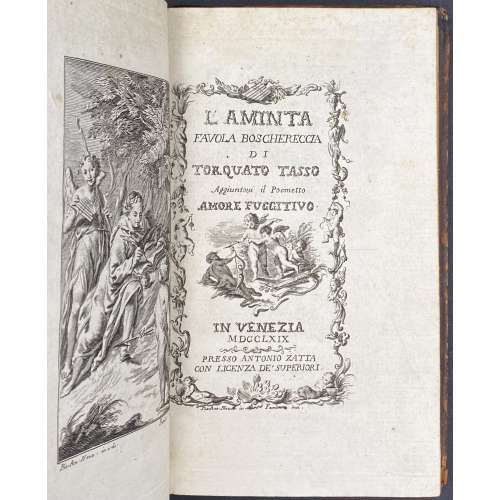 Engraved title-page: L'AMINTA | FAVOLA BOSCHERECCIA | DI | TORQUATO TASSO | Aggiuntovi il Poemetto | Amore Fugitivo |{vignette} | IN VENEZIA | MDCCLXIX |—| PRESSO ANTONIO ZATTA | CON LICENZA DE’ SUPERIORI || in historiated frame, signed below: “Pet. Ant. Novelli in — Fambrini inci.” Pagination: [i] ii-xxiv, [1-2] 3-84, total 108 pages, ils. Collation: 12mo; a12, A-C12 D6, last blank; first 6 leaves signed in 12-leave quires, first 3 in D; total 54 leaves plus 9 plates, incl. engraved title and frontispiece, and numerous head- and tailpieces by Fambrini after Novelli. Binding: 18.6 x 11 cm, contemporary tree calf, rebacked, crimson label with gilt lettering; clipping and bookplate of The Robin Collection to front pastedown; verso front flyleaf stamped “RESTORED BY MACDONALD CO. | NORWALK. CONN.” Additional blank leaves at front and back. Provenance: Satinsky, Robin F. (American, 1919 – 2008); The Robin Collection. Contributors: Torquato Tasso (Italian, 1544 –1595) – author. Pietro Antonio Novelli (Italian, 1729 – 1804) – artist. Ferdinando Fambrini (Italian (1764 – c.1793) – engraver. Antonio Zatta (Italian, c. 1722 – 1804) – printer, publisher.
Engraved title-page: L'AMINTA | FAVOLA BOSCHERECCIA | DI | TORQUATO TASSO | Aggiuntovi il Poemetto | Amore Fugitivo |{vignette} | IN VENEZIA | MDCCLXIX |—| PRESSO ANTONIO ZATTA | CON LICENZA DE’ SUPERIORI || in historiated frame, signed below: “Pet. Ant. Novelli in — Fambrini inci.” Pagination: [i] ii-xxiv, [1-2] 3-84, total 108 pages, ils. Collation: 12mo; a12, A-C12 D6, last blank; first 6 leaves signed in 12-leave quires, first 3 in D; total 54 leaves plus 9 plates, incl. engraved title and frontispiece, and numerous head- and tailpieces by Fambrini after Novelli. Binding: 18.6 x 11 cm, contemporary tree calf, rebacked, crimson label with gilt lettering; clipping and bookplate of The Robin Collection to front pastedown; verso front flyleaf stamped “RESTORED BY MACDONALD CO. | NORWALK. CONN.” Additional blank leaves at front and back. Provenance: Satinsky, Robin F. (American, 1919 – 2008); The Robin Collection. Contributors: Torquato Tasso (Italian, 1544 –1595) – author. Pietro Antonio Novelli (Italian, 1729 – 1804) – artist. Ferdinando Fambrini (Italian (1764 – c.1793) – engraver. Antonio Zatta (Italian, c. 1722 – 1804) – printer, publisher. -
 Ippitsusai Bunchō [一筆斎文調] (Japanese, 1725 – 1794). Size: Vertical Hosoban. As the Library of Congress put it: "Print shows the actor Ichikawa Monnosuke II, full-length portrait, facing left, standing on the snow-covered veranda". Actor: Ichikawa Monnosuke II [市川門之助] (Japanese, 1743/56 – 1794); other names: Ichikawa Benzō I, Takinaka Hidematsu II, Takinaka Tsuruzō. According to Heroes of the Kabuki Stage [LIB-1197.2016] Ichikawa Monnosuke II was active from 11/1770 to 10/1794. Play: Chūshingura [忠臣蔵] (The Treasury of Loyal Retainers), played at Nakamuraza in the 4the month of Meiwa 8 (1771). The actor played in a variety of roles and performances and was the subject of multiple woodblock prints by many famous ukiyo-e artists, including Bunchō, Katukawa Shunkō, Katukawa Shunshō, Katsukawa Shun'ei, Tōshūsai Sharaku, and many others. Ref: Vever (1976), vol. 1, № 242, p. 227.
Ippitsusai Bunchō [一筆斎文調] (Japanese, 1725 – 1794). Size: Vertical Hosoban. As the Library of Congress put it: "Print shows the actor Ichikawa Monnosuke II, full-length portrait, facing left, standing on the snow-covered veranda". Actor: Ichikawa Monnosuke II [市川門之助] (Japanese, 1743/56 – 1794); other names: Ichikawa Benzō I, Takinaka Hidematsu II, Takinaka Tsuruzō. According to Heroes of the Kabuki Stage [LIB-1197.2016] Ichikawa Monnosuke II was active from 11/1770 to 10/1794. Play: Chūshingura [忠臣蔵] (The Treasury of Loyal Retainers), played at Nakamuraza in the 4the month of Meiwa 8 (1771). The actor played in a variety of roles and performances and was the subject of multiple woodblock prints by many famous ukiyo-e artists, including Bunchō, Katukawa Shunkō, Katukawa Shunshō, Katsukawa Shun'ei, Tōshūsai Sharaku, and many others. Ref: Vever (1976), vol. 1, № 242, p. 227.
Katsukawa Shun'ei. The Actor Ichikawa Monnosuke II in an Aragoto Role. LACME.

Actor Ichikawa Monnosuke II as Date no Yosaku Artist Tôshûsai Sharaku (Japanese, active 1794–1795), Publisher Tsutaya Jûzaburô (Kôshodô) (Japanese) 1794 (Kansei 6), 5th month. MFA.

Ippitsusai Bunchô. Actor Ichikawa Monnosuke II as Tsunewakamaru. Play: Iro Moyô Aoyagi Soga Theater: Nakamura. MFA.
-
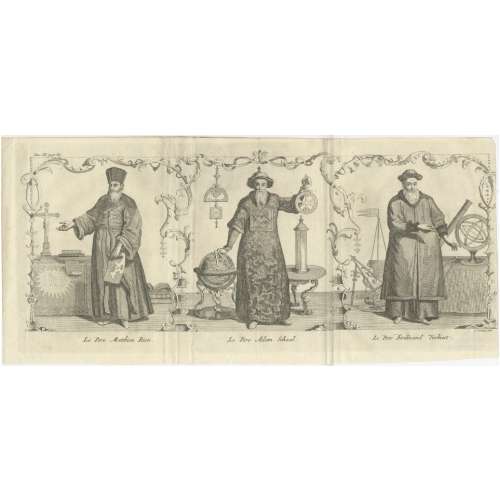
Three priests: Le Pere Matthieu Ricci, Le Pere Adam Schaal, and Le Pere Ferdinand Verbiest. Three priests with navigational instruments. Image taken from Description geographique, historique, chronologique et physique de l'Empire de la Chine et de la Tartarie Chinoise. Enrichies des cartes generales et particulieres de ces pays, etc. by Jean-Baptiste Du Halde (1674–1743), vol. 3, page 78. Originally published/produced in La Haye [The Hague], 1736. J.v.Solingen fecit
Jean-Baptiste Du Halde (Chinese: 杜赫德; 1 February 1674 – 18 August 1743) was a French Jesuit historian specializing in China. He did not travel to China, but collected seventeen Jesuit missionaries' reports and provided an encyclopedic survey of the history, culture and society of China and "Chinese Tartary," that is, Manchuria. Voltaire said of Du Halde's work: "Although it is developed out of Paris, and he hath not known the Chinese, [he] gave on the basis of the memoirs of his colleagues, the widest and the best description the empire of China has had worldwide." Le Pere Matthieu Ricci, a.k.a. Matteo Ricci, S.J. (Italian pronunciation: [matˈtɛːo ˈrittʃi]; Latin: Mattheus Riccius Maceratensis; 6 October 1552 – 11 May 1610), was an Italian Jesuit priest and one of the founding figures of the Jesuit China missions. His 1602 map of the world in Chinese characters introduced the findings of European exploration to East Asia. He is considered a Servant of God by the Roman Catholic Church. Ricci arrived at the Portuguese settlement of Macau in 1582 where he began his missionary work in China. He became the first European to enter the Forbidden City of Beijing in 1601 when invited by the Wanli Emperor, who sought his services in matters such as court astronomy and calendrical science. He converted several prominent Chinese officials to Catholicism, such as Xu Guangqi, who aided in translating Euclid's Elements into Chinese as well as the Confucian classics into Latin for the first time. Le Pere Adam Schaal, a.k.a. Johann Adam Schall von Bell (1 May 1591 – 15 August 1666) was a German Jesuit and astronomer. He spent most of his life as a missionary in China (where he is remembered as "Tang Ruowang") and became an adviser to the Shunzhi Emperor of the Qing dynasty. Le Pere Ferdinand Verbiest, a.k.a. Father Ferdinand Verbiest (9 October 1623 – 28 January 1688) was a Flemish Jesuit missionary in China during the Qing dynasty. He was born in Pittem near Tielt in the County of Flanders (now part of Belgium). He is known as Nan Huairen (南懷仁) in Chinese. He was an accomplished mathematician and astronomer and proved to the court of the Kangxi Emperor that European astronomy was more accurate than Chinese astronomy. He then corrected the Chinese calendar and was later asked to rebuild and re-equip the Beijing Ancient Observatory, being given the role of Head of the Mathematical Board and Director of the Observatory. He became close friends with the Kangxi Emperor, who frequently requested his teaching, in geometry, philosophy and music. Verbiest worked as a diplomat and cartographer, and also as a translator because he spoke Latin, German, Dutch, Spanish, Hebrew, and Italian. He wrote more than thirty books. During the 1670s, Verbiest designed what some claim to be the first ever self-propelled vehicle – many claims this as the world's first automobile, in spite of its small size and the lack of evidence that it was actually built.Joshua Van Solingen was an engraver and publisher from Holland, working, besides other places, in Scotland. Information about him can be found at Catastrophic Bliss (The Griot Project Book Series) by Accounting in Scotland (RLE Accounting): A Historical Bibliography History of the Scottish Metrical Psalms: With an Account of the Paraphrases ... The History of Edinburgh, from the Earliest Accounts to the Present Time ... History of the Bassandyne Bible, the First Printed in Scotland: With Notices ...
-
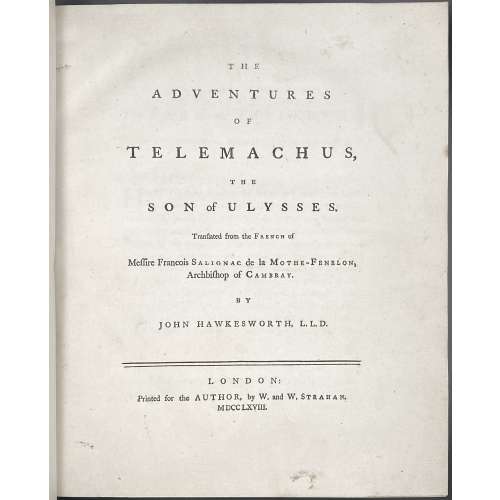 THE | ADVENTURES | OF | TELEMACHUS, | THE SON OF ULYSSES. | Translated from the French of | Messire François Salignac de la Mothe–Fenelon, | Archbishop of Cambray. | BY | JOHN HAWKESWORTH, L. L. D. | — | LONDON: | Printed for the AUTHOR, by W. and W. Strahan, | M DCC LXVIII. || Binding: half polished brown calf over marbled boards, wave ruled blind, gilt fillet ruled compartments, black label with gilt lettering to spine; 29.5 x 24.5 cm; marbled endpapers. Pagination: 2 blank leaves (wove paper), [I, ii] – t.p. / blank, [iii] iv – dedication, [v] vi-xv – subscribers, [xvi] blank, [xvii] xviii-xix – preface, [xx] xxi-xxxv – contents, [xxxvi] – errata, subscribers omitted, [1] 2-462, printed on laid paper, 2 blank leaves (wove paper). Collation: 4to; A4, a-c4 d2, B-Z4 Aa-Zz4 Aaa-Mmm4 Nnn3; 24 head- and 24 tailpieces engraved by Charles Grignion the Elder (British, 1721 – 1810) after Samuel Waly (British, 1720 – 1786). Original: François Fénelon. Les Aventures de Télémaque, fils d’Ulysse. See № LIB-2522-2020 in this collection. Not in Lewine, 1898; Not in Cohen De Ricci, 1912.
THE | ADVENTURES | OF | TELEMACHUS, | THE SON OF ULYSSES. | Translated from the French of | Messire François Salignac de la Mothe–Fenelon, | Archbishop of Cambray. | BY | JOHN HAWKESWORTH, L. L. D. | — | LONDON: | Printed for the AUTHOR, by W. and W. Strahan, | M DCC LXVIII. || Binding: half polished brown calf over marbled boards, wave ruled blind, gilt fillet ruled compartments, black label with gilt lettering to spine; 29.5 x 24.5 cm; marbled endpapers. Pagination: 2 blank leaves (wove paper), [I, ii] – t.p. / blank, [iii] iv – dedication, [v] vi-xv – subscribers, [xvi] blank, [xvii] xviii-xix – preface, [xx] xxi-xxxv – contents, [xxxvi] – errata, subscribers omitted, [1] 2-462, printed on laid paper, 2 blank leaves (wove paper). Collation: 4to; A4, a-c4 d2, B-Z4 Aa-Zz4 Aaa-Mmm4 Nnn3; 24 head- and 24 tailpieces engraved by Charles Grignion the Elder (British, 1721 – 1810) after Samuel Waly (British, 1720 – 1786). Original: François Fénelon. Les Aventures de Télémaque, fils d’Ulysse. See № LIB-2522-2020 in this collection. Not in Lewine, 1898; Not in Cohen De Ricci, 1912. -
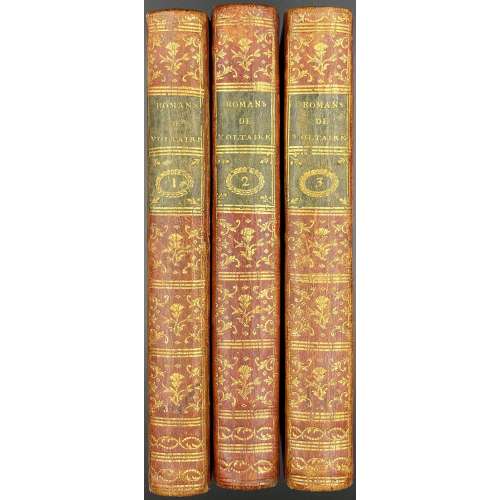 Three volumes, 8vo, 20.5 x 13.5 cm each, uniformly bound in crimson morocco, ruled in triple-fillet gilt, flat spine, triple-fillet gilt-ruled compartments with gilt elements in compartments, two black labels lettered in gilt, marbled endpapers, all edges gilt, multiple woodcut tailpieces. Armorial bookplate of Henricus Liber Baro de Gudenus to front pastedowns in all volumes: “HENRICVS LIBER BARO | DE GVDENVS | 1891 | Jauner”. Title-page: ROMANS | ET | CONTES | DE | M. DE VOLTAIRE | {chain rule} | TOME PREMIER (SECOND; TROISIEME). | {chain rule} | {publisher’s device with motto: “nuper sub modio nunc super”} | A BOUILLON, | AUX DEPENS DE LA SOCIETE TYPOGRAPHIQUE. | {floral rule} | M. DCC. LXXVIII. || Vol. 1: Collation: π2 (h.t., t.p.) a1 (table), A-T8, (Aiv unsigned), total 155 leaves plus 16 leaves of plates, incl. frontispiece, and two blanks – first and last, extraneous to collation. Frontispiece by Cathelin after de La Tour, unsigned t.p. vignette (device), 5 unsigned headpieces, and 15 plates after Monnet by Chatelin, Dambrun (5) Deny (6), Thiébault (2), and Vidal. Pagination: [i-v] vi [1-3] 4-304, total 310 pages, ils. Vol. 2: Collation: π2 (h.t., t.p.) a2 (table), A-V8, total 164 leaves plus 20 leaves of plates, incl. frontispiece, extraneous to collation, no blanks. Frontispiece by Dambrun after Monnet, unsigned t.p. vignette (device), 3 headpieces by Deny after Monnet, 2 unsigned headpieces, 19 plates: after Martiny by Deny; after Monnet by Baquoy, Dambrun (3), Deny (9), and Vidal (4); and after Moreau by Deny. Pagination: [i-v] vi-viii [1-3] 4-320, total 328 pages, ils. Vol.3: π2 (h.t., t.p.) a1 (table), A-O8 P6 a-f8 g1 h2 ('avis au relieur'), total 172 leaves plus 21 leaves of plates, incl. frontispiece, extraneous to collation, no blanks. Frontispiece by Dambrun after Monnet, unsigned t.p. vignette (device), indistinctly signed headpiece to “Jenni” after Monnet (probably Thiébault), 2 unsigned headpieces, 20 plates: after Marillier by Deny (4), Lorieux (2), Patas, and Vidal. Pagination: [i-v] vi [1-3] 4-236, [1-2] 3-102, total 328 pages, ils. Provenance: Heinrich von Gudenus [Heinrich Johann Baptist Ghislain von Gudenus] (Austrian, 1839 – 1915); ref.: Bibliotheca Ecclesiae Metropolitanae Strigoniensis. Catalogue raisonné: Ray (French): № 35, pp. 71-2; Cohen - de Ricci: 1038-9; Lewine: 562-3. Contributors: François Marie Arouet de Voltaire (French, 1694 – 1778) – author. Artists: Clément Pierre Marillier (French, 1740 – 1808) Maurice Quentin de La Tour (French, 1704 – 1788) Charles Monnet [Monet] (French, 1732 – 1819) Pietro Antonio Martini (Italian, 1738 – 1797) Jean-Michel Moreau [Moreau le Jeune] (French, 1741 – 1814) Engravers: Jean Charles Baquoy (French, 1721–1777) Louis-Jacques Cathelin (French, 1738 – 1804) John Baptist Chatelain (British, 1710 – 1758) Jean Dambrun (French, 1741 – 1808/14) Jeanne Deny (French, 1749 – c. 1815) Martial Deny (French, b. 1745) F. B. Lorieux (French, fl. 1786 – 1810) Charles Emmanuel Patas (French, 1744 – 1802) Elisabeth Thiébault (French, 18th century) Gérard Vidal (French, 1742 – 1801)
Three volumes, 8vo, 20.5 x 13.5 cm each, uniformly bound in crimson morocco, ruled in triple-fillet gilt, flat spine, triple-fillet gilt-ruled compartments with gilt elements in compartments, two black labels lettered in gilt, marbled endpapers, all edges gilt, multiple woodcut tailpieces. Armorial bookplate of Henricus Liber Baro de Gudenus to front pastedowns in all volumes: “HENRICVS LIBER BARO | DE GVDENVS | 1891 | Jauner”. Title-page: ROMANS | ET | CONTES | DE | M. DE VOLTAIRE | {chain rule} | TOME PREMIER (SECOND; TROISIEME). | {chain rule} | {publisher’s device with motto: “nuper sub modio nunc super”} | A BOUILLON, | AUX DEPENS DE LA SOCIETE TYPOGRAPHIQUE. | {floral rule} | M. DCC. LXXVIII. || Vol. 1: Collation: π2 (h.t., t.p.) a1 (table), A-T8, (Aiv unsigned), total 155 leaves plus 16 leaves of plates, incl. frontispiece, and two blanks – first and last, extraneous to collation. Frontispiece by Cathelin after de La Tour, unsigned t.p. vignette (device), 5 unsigned headpieces, and 15 plates after Monnet by Chatelin, Dambrun (5) Deny (6), Thiébault (2), and Vidal. Pagination: [i-v] vi [1-3] 4-304, total 310 pages, ils. Vol. 2: Collation: π2 (h.t., t.p.) a2 (table), A-V8, total 164 leaves plus 20 leaves of plates, incl. frontispiece, extraneous to collation, no blanks. Frontispiece by Dambrun after Monnet, unsigned t.p. vignette (device), 3 headpieces by Deny after Monnet, 2 unsigned headpieces, 19 plates: after Martiny by Deny; after Monnet by Baquoy, Dambrun (3), Deny (9), and Vidal (4); and after Moreau by Deny. Pagination: [i-v] vi-viii [1-3] 4-320, total 328 pages, ils. Vol.3: π2 (h.t., t.p.) a1 (table), A-O8 P6 a-f8 g1 h2 ('avis au relieur'), total 172 leaves plus 21 leaves of plates, incl. frontispiece, extraneous to collation, no blanks. Frontispiece by Dambrun after Monnet, unsigned t.p. vignette (device), indistinctly signed headpiece to “Jenni” after Monnet (probably Thiébault), 2 unsigned headpieces, 20 plates: after Marillier by Deny (4), Lorieux (2), Patas, and Vidal. Pagination: [i-v] vi [1-3] 4-236, [1-2] 3-102, total 328 pages, ils. Provenance: Heinrich von Gudenus [Heinrich Johann Baptist Ghislain von Gudenus] (Austrian, 1839 – 1915); ref.: Bibliotheca Ecclesiae Metropolitanae Strigoniensis. Catalogue raisonné: Ray (French): № 35, pp. 71-2; Cohen - de Ricci: 1038-9; Lewine: 562-3. Contributors: François Marie Arouet de Voltaire (French, 1694 – 1778) – author. Artists: Clément Pierre Marillier (French, 1740 – 1808) Maurice Quentin de La Tour (French, 1704 – 1788) Charles Monnet [Monet] (French, 1732 – 1819) Pietro Antonio Martini (Italian, 1738 – 1797) Jean-Michel Moreau [Moreau le Jeune] (French, 1741 – 1814) Engravers: Jean Charles Baquoy (French, 1721–1777) Louis-Jacques Cathelin (French, 1738 – 1804) John Baptist Chatelain (British, 1710 – 1758) Jean Dambrun (French, 1741 – 1808/14) Jeanne Deny (French, 1749 – c. 1815) Martial Deny (French, b. 1745) F. B. Lorieux (French, fl. 1786 – 1810) Charles Emmanuel Patas (French, 1744 – 1802) Elisabeth Thiébault (French, 18th century) Gérard Vidal (French, 1742 – 1801) -
 Katsukawa Shunshō ( 勝川 春章; 1726 – 19 January 1793).
Katsukawa Shunshō ( 勝川 春章; 1726 – 19 January 1793).SIZE: 12.5 x 5.75 in.
-
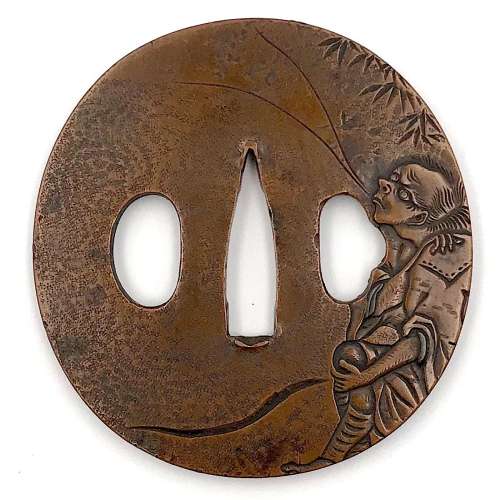
Copper tsuba of oval form carved in kebori and katakiribori with Tekkai Sennin sitting under bamboo on the face and with a pine tree on the back. Ishime-ji treated surface.
Signed on the reverse: Jōi (乗 意).
Edo period (First half of 18th century). Dimensions: 69.6 x 66.5 x 4.5 mm Sugiura Jōi (杉 浦 乗 意) was a master of Nara School in Edo; he was a student of Toshinaga [M. Sesko, 'Genealogies', p. 32]. "Sugiura Jōi (1701-1761) made many fuchigashira and kozuka, tsuba are rather rare." [M. Sesko, The Japanese toso-kinko Schools]. -
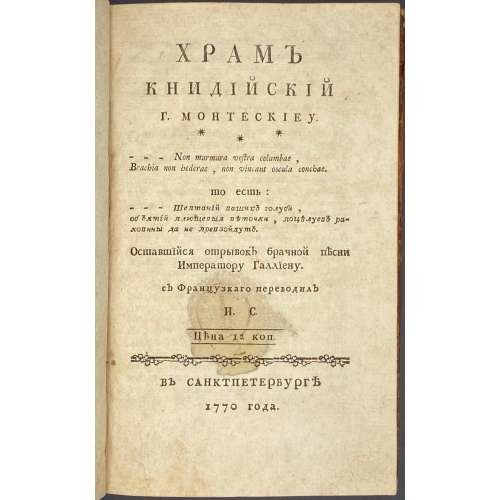 Шарль Монтескье. Храм Книдийский (пер. Иван Сичкарев). Лисимах. Разговор Суллы с Эвкратом. Опыт о вкусе (пер. Семён Башилов). — СПб.: [Тип. Акад. наук], 1770. Pagination: [2 blank] [2 t.p. храм, blank] [4 preface] [1] 2-72, [1, 2 t.p. лисимах, blank] [1] 2-12 [13, 14 t.p. силла] 16-33, [34 blank] [35, 37 t.p. опыт, blank] 38-95 [96 errata] [2 blank]. Size: 12mo, 20 x 12.5 cm, Binding: Contemporary polished brown slightly stained calf, gilt-ruled borders, flat spine with gilt bands and tools in compartments, black title label with gilt lettering to spine, marbled end-papers. Inscriptions and marks: Ink hand-writing to ff: "Люб. Дубенская, Москва XII 1931"; "Ленкнигторг" label glued to the recto of back free leaf; "Антикварная торговля В. И. Клочкова. СПБ., Литейный 55" label pasted to back pastedown. Printed on laid paper with "key" image printed on recto and protruding to the verso to t.p. of Храм Книдийский and Лисимах. Imperial orthography. Engraved head and tailpieces.
Шарль Монтескье. Храм Книдийский (пер. Иван Сичкарев). Лисимах. Разговор Суллы с Эвкратом. Опыт о вкусе (пер. Семён Башилов). — СПб.: [Тип. Акад. наук], 1770. Pagination: [2 blank] [2 t.p. храм, blank] [4 preface] [1] 2-72, [1, 2 t.p. лисимах, blank] [1] 2-12 [13, 14 t.p. силла] 16-33, [34 blank] [35, 37 t.p. опыт, blank] 38-95 [96 errata] [2 blank]. Size: 12mo, 20 x 12.5 cm, Binding: Contemporary polished brown slightly stained calf, gilt-ruled borders, flat spine with gilt bands and tools in compartments, black title label with gilt lettering to spine, marbled end-papers. Inscriptions and marks: Ink hand-writing to ff: "Люб. Дубенская, Москва XII 1931"; "Ленкнигторг" label glued to the recto of back free leaf; "Антикварная торговля В. И. Клочкова. СПБ., Литейный 55" label pasted to back pastedown. Printed on laid paper with "key" image printed on recto and protruding to the verso to t.p. of Храм Книдийский and Лисимах. Imperial orthography. Engraved head and tailpieces. -
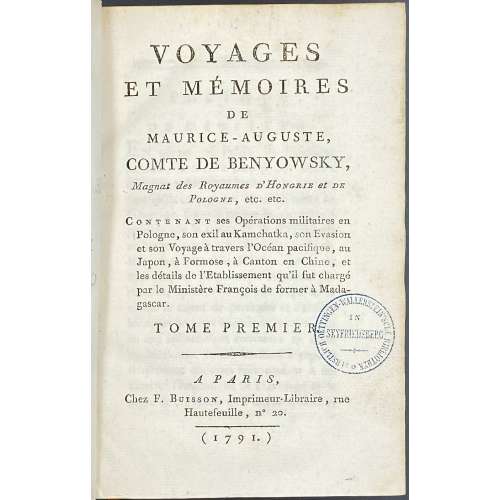 Vol. 1. Title : VOYAGES | ET MÉMOIRES | DE | MAURICE-AUGUSTE, | COMTE DE BENYOWSKY, | Magnat des Royaumes d’Hongrie et de | Pologne, etc. etc. | Contenant ses Opérations militaires en | Pologne, son exil au Kamtchatka, son Evasion | et son Voyage à travers l’Océan pacifique, au | Japon, à Formose, à Canton en Chine, et | les détails de l’Etablissement qu’il fut chargé | par le Ministère François de former à Mada- | gascar. | TOME PREMIER. | A PARIS, Chez F. Buisson, Imprimeur-Libraire, rue | Hautefeuille, no 20. | (1791.) Pagination : [2] – h.t. / blank, [2] – t.p. / blank, [i] ii-viii, [1] 2-466. Collation: 8vo; [π]2 a4, A-Ff8 Gg1. Vol. 2. Title: Similar, but TOME SECOND. Pagination: [2] – h.t. / blank, [2] – t.p. / blank, [1] 2-486. Collation: 8vo; [π]2 A-Gg8 Hh3, Hh3 unsigned. Binding: both volumes uniformly bound in half brown calf over speckled beige boards, crimson label with gilt lettering to flat spine, volume number in garland, florets in compartments. Bookplate to front pastedown: "C. De Oetting." Ink stamp to t.p.: "Oettingen-Wallersteinsche Bibliothek". Provenance: Oettingen-Wallerstein library (Oettingen-Wallersteinsche Bibliothek) is the former library of the princes of Oettingen-Wallerstein, now part of the collection of Augsburg University library.
Vol. 1. Title : VOYAGES | ET MÉMOIRES | DE | MAURICE-AUGUSTE, | COMTE DE BENYOWSKY, | Magnat des Royaumes d’Hongrie et de | Pologne, etc. etc. | Contenant ses Opérations militaires en | Pologne, son exil au Kamtchatka, son Evasion | et son Voyage à travers l’Océan pacifique, au | Japon, à Formose, à Canton en Chine, et | les détails de l’Etablissement qu’il fut chargé | par le Ministère François de former à Mada- | gascar. | TOME PREMIER. | A PARIS, Chez F. Buisson, Imprimeur-Libraire, rue | Hautefeuille, no 20. | (1791.) Pagination : [2] – h.t. / blank, [2] – t.p. / blank, [i] ii-viii, [1] 2-466. Collation: 8vo; [π]2 a4, A-Ff8 Gg1. Vol. 2. Title: Similar, but TOME SECOND. Pagination: [2] – h.t. / blank, [2] – t.p. / blank, [1] 2-486. Collation: 8vo; [π]2 A-Gg8 Hh3, Hh3 unsigned. Binding: both volumes uniformly bound in half brown calf over speckled beige boards, crimson label with gilt lettering to flat spine, volume number in garland, florets in compartments. Bookplate to front pastedown: "C. De Oetting." Ink stamp to t.p.: "Oettingen-Wallersteinsche Bibliothek". Provenance: Oettingen-Wallerstein library (Oettingen-Wallersteinsche Bibliothek) is the former library of the princes of Oettingen-Wallerstein, now part of the collection of Augsburg University library. -
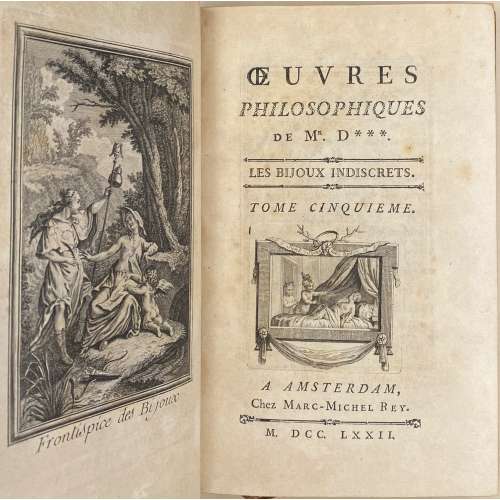 One volume, collated 8vo, 19.5 x 13 cm, later bound in brown full morocco by Pouillet, gilt-bordered covers, raised bands to spine, gilt in compartments, gilt-lettered, double-fillet on cover edges, gilt dentelle inside, signed, all edges gilt, marbled endpapers. Title-page: ŒUVRES | PHILOSOPHIQUES | DE MR. D ***. | — | LES BIJOUX INDISCRETS | — | TOME CINQUIEME | {vignette} | A AMSTERDAM, | Chez Marc-Michel Rey. | — | M. DCC. LXXII. || Pagination: [8] [1] 2-389 [390], total 398 pages, frontis., vignette, plates. Collation: 3 blank leaves at front and rear, π2 a2 A-Aa8 Bb3, total 199 leaves plus 7 unsigned engraved plates incl. frontispiece, and engraved vignette to t.p. Catalogue raisonné: Cohen-DeRicci 303; Lewine 145-6: …with the plates which have been copied and reduced in the undated Cazin edition (1771 and 1785). Contributors: Marc-Michel Rey (Dutch, 1720 – 1780) – publisher. Denis Diderot (French, 1713 – 1784) – author.
One volume, collated 8vo, 19.5 x 13 cm, later bound in brown full morocco by Pouillet, gilt-bordered covers, raised bands to spine, gilt in compartments, gilt-lettered, double-fillet on cover edges, gilt dentelle inside, signed, all edges gilt, marbled endpapers. Title-page: ŒUVRES | PHILOSOPHIQUES | DE MR. D ***. | — | LES BIJOUX INDISCRETS | — | TOME CINQUIEME | {vignette} | A AMSTERDAM, | Chez Marc-Michel Rey. | — | M. DCC. LXXII. || Pagination: [8] [1] 2-389 [390], total 398 pages, frontis., vignette, plates. Collation: 3 blank leaves at front and rear, π2 a2 A-Aa8 Bb3, total 199 leaves plus 7 unsigned engraved plates incl. frontispiece, and engraved vignette to t.p. Catalogue raisonné: Cohen-DeRicci 303; Lewine 145-6: …with the plates which have been copied and reduced in the undated Cazin edition (1771 and 1785). Contributors: Marc-Michel Rey (Dutch, 1720 – 1780) – publisher. Denis Diderot (French, 1713 – 1784) – author. -
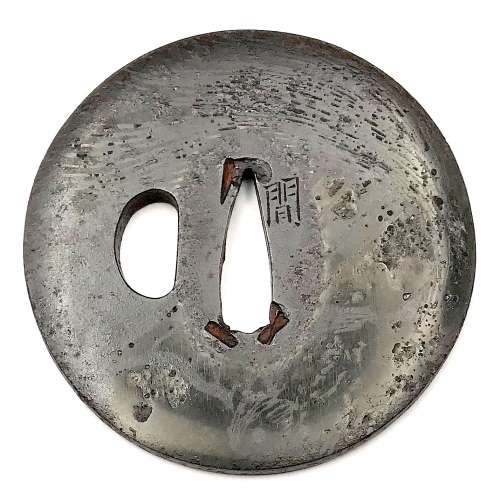 Iron tsuba of round form (width > height) decorated with a squirrel (on the face) and bamboo (on the reverse) motif in sahari flat inlay (hira-zōgan). Signed: Hazama (間) Size: 75.1mm x 75.9mm, thickness of seppa-dai 5.4mm. Early 18th century, mid Edo. Haynes/Torigoye: "There is another name for Hazama tsuba: the Kameyama school. In the period from Hōei to Kyōhō (1704-36) at Kameyama, in the province of Ise, the Kunitomo family made this style of tsuba" [...] The two artists who are best known for the sahari style of inlaid tsuba are Sadahide and Masahide" [...] The signature Hazama should be considered as that of Masahide". Sahari inlay is the distinctive characteristics of Hazama school. Sahari is an alloy of copper, tin, lead, zinc and silver. Hazama tsuba was carved patterns at first, then poured heated into the carvings on iron ground. Because it is an alloy, sahari shows different colors in each tsuba. According to Merrily Baird [Symbols, p. 163], "squirrels (risu) ... have no symbolic importance". NBTHK certificate №448388.
Iron tsuba of round form (width > height) decorated with a squirrel (on the face) and bamboo (on the reverse) motif in sahari flat inlay (hira-zōgan). Signed: Hazama (間) Size: 75.1mm x 75.9mm, thickness of seppa-dai 5.4mm. Early 18th century, mid Edo. Haynes/Torigoye: "There is another name for Hazama tsuba: the Kameyama school. In the period from Hōei to Kyōhō (1704-36) at Kameyama, in the province of Ise, the Kunitomo family made this style of tsuba" [...] The two artists who are best known for the sahari style of inlaid tsuba are Sadahide and Masahide" [...] The signature Hazama should be considered as that of Masahide". Sahari inlay is the distinctive characteristics of Hazama school. Sahari is an alloy of copper, tin, lead, zinc and silver. Hazama tsuba was carved patterns at first, then poured heated into the carvings on iron ground. Because it is an alloy, sahari shows different colors in each tsuba. According to Merrily Baird [Symbols, p. 163], "squirrels (risu) ... have no symbolic importance". NBTHK certificate №448388. -
 Kikukawa Eizan (菊川 英山, 1787 – July 17, 1867) Signed: Eizan hitsu (英山筆)
Kikukawa Eizan (菊川 英山, 1787 – July 17, 1867) Signed: Eizan hitsu (英山筆)Jacob Pins #972/p.341. Leiden, Rijksmuseum voor Volkenkunde.
"The Lovers Miura-ya Komurasaki and Shirai Gonpachi: Tragic love stories taken from real life and dramatized were a staple of stage and print; the darkly romantic combination of desire and death was hugely popular in the eighteenth century. Hirai Gompachi was a warrior of the Tottori fief in western Japan who fled to Edo after committing a murder. He was apprehended and sentenced to death in 1679. His distraught lover, the courtesan Komurasaki, committed suicide at his grave." [MET]
.
-
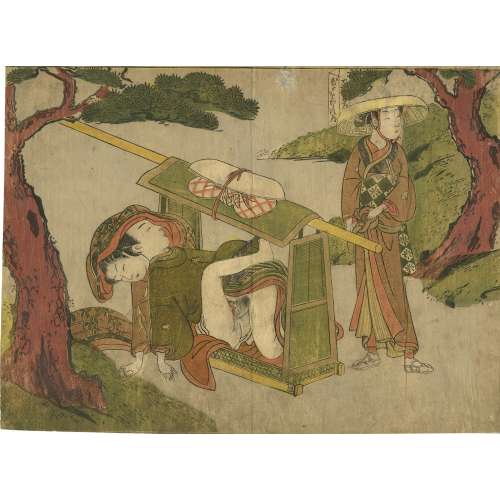 A shunga (erotic) print by Suzuki Harunobu [鈴木 春信] (Japanese, c. 1725 – 1770) depicting a woman making love with a man in the palanquin (のりもの/乗り物) while the other woman "ties a sash about her hips below her obi." The sheet is not signed; however, it is attributed to Harunobu. A reference image can be found in the Metropolitan Museum (NY) collection, Accession Number JP1635:According to the MET "the palanquin ... has carried these courtesans to the shore for a spring outing". Some time ago, a similar print was sold by Richard Kruml (description: A chuban shunga print showing the occupant of a kago in flagrante with one of the porters, having seized the opportunity of a stop on the journey. Published late 1760s. Rare). Another copy was sold at Sotheby's in Paris for €3,360 on November 27, 2002 (Lot 24), with a reproduction of the print's detail and description on p. 39: Suzuki Harunobu (1725 – 1770) | Shunga: couple dans un palanquin, vers 1768-1770, non-signe, cachet non identifé, cachets Charles Mitchell, Huguette Berès, Format chuban, 20.1 x 28.6 cm | 3000 – 4000 € | Il s’agit probablement de trois voyageurs, l’un d’entre eux debout près du palanquin faisant mine d’ignorer la scène. Bibliographie: Delay p. 87. Reference: [LIB-3121.2022] Sotheby's: Collection Huguette Berès – Estampes, dessins et livres illustrés japonais / 2 volumes; vol. 1. — Paris: Sotheby's, 2002.
A shunga (erotic) print by Suzuki Harunobu [鈴木 春信] (Japanese, c. 1725 – 1770) depicting a woman making love with a man in the palanquin (のりもの/乗り物) while the other woman "ties a sash about her hips below her obi." The sheet is not signed; however, it is attributed to Harunobu. A reference image can be found in the Metropolitan Museum (NY) collection, Accession Number JP1635:According to the MET "the palanquin ... has carried these courtesans to the shore for a spring outing". Some time ago, a similar print was sold by Richard Kruml (description: A chuban shunga print showing the occupant of a kago in flagrante with one of the porters, having seized the opportunity of a stop on the journey. Published late 1760s. Rare). Another copy was sold at Sotheby's in Paris for €3,360 on November 27, 2002 (Lot 24), with a reproduction of the print's detail and description on p. 39: Suzuki Harunobu (1725 – 1770) | Shunga: couple dans un palanquin, vers 1768-1770, non-signe, cachet non identifé, cachets Charles Mitchell, Huguette Berès, Format chuban, 20.1 x 28.6 cm | 3000 – 4000 € | Il s’agit probablement de trois voyageurs, l’un d’entre eux debout près du palanquin faisant mine d’ignorer la scène. Bibliographie: Delay p. 87. Reference: [LIB-3121.2022] Sotheby's: Collection Huguette Berès – Estampes, dessins et livres illustrés japonais / 2 volumes; vol. 1. — Paris: Sotheby's, 2002.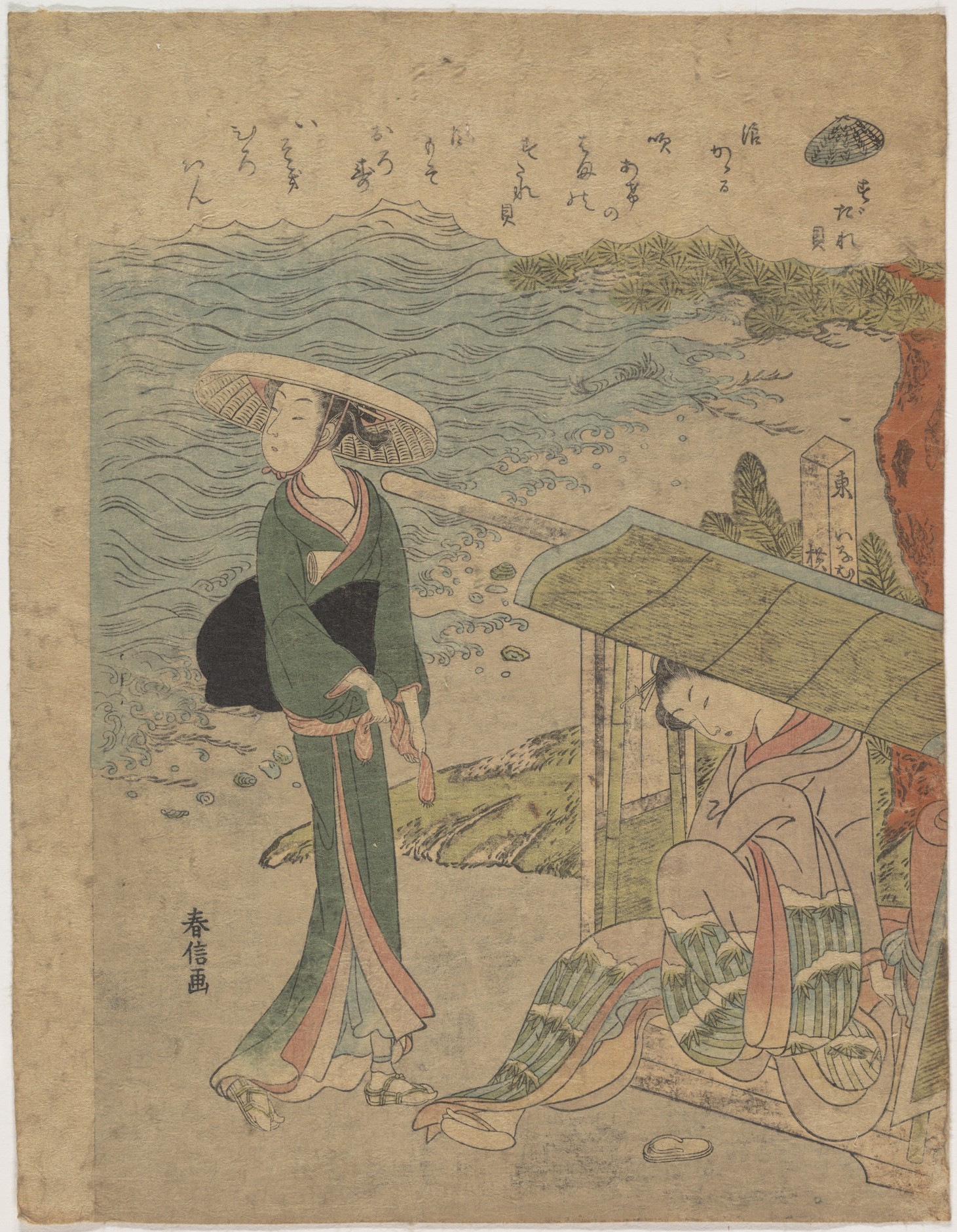
http://www.metmuseum.org/art/collection/search/45071
-
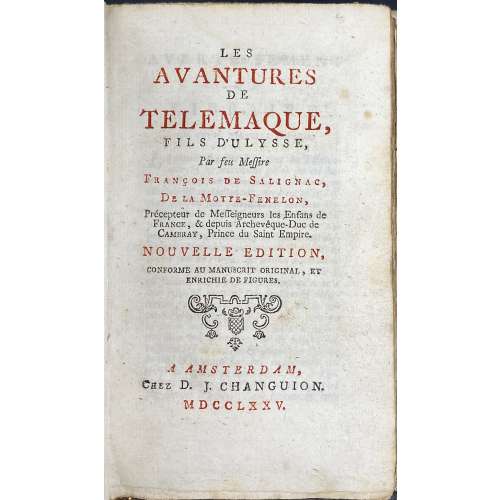 Title-page (in red and black, with tall “s”): LES | AVANTURES | DE | TELEMAQUE, | FILS D'ULYSSE, | Par seu Messire | François de Salignac, | De La Motte-Fenelon, | Precepteur de Messeigneurs les Enfans de | France, & depuis Archevêque-Duc de | Cambray, Prince du Saint Empire. | NOUVELLE EDITION, | CONFORME AU MANUSCRIT ORIGINAL, ET | ENRICHIE DE FIGURES. | {device} | A AMSTERDAM, | Chez D. J. CHANGUION. | MDCCXXV. || Pagination: fep, 1 bank leaves, frontis., [ii] title, [iii] iv-cvi, [1] 2-490 2 blank leaves, fep, total 496 pages. Collation: 12mo; 1*-4*12 5*5, A-V12 X8 (total 248 leaves) plus frontispiece and 9 plates designed and engraved by Simon Fokke (signed: “S. Fokke in et fec 1753”), and folding map (not signed). Binding: Red quarter roan over contemporary marbled vellum, only top margin trimmed. Edition: 2nd edition with these etchings after the 1st by Jan Daniel Beman in Rotterdam in 1755 (see British Museum 1887,0722.88 and 1887,0722.90 and others.) Catalogue raisonné: Not in Cohen-DeRicci, not in Lewine. Contributors: François Fénelon [François de Salignac de la Mothe-Fénelon] (French, 1651 – 1715) – author. Simon Fokke (Dutch, 1712 – 1784) – artist, engarver.
Title-page (in red and black, with tall “s”): LES | AVANTURES | DE | TELEMAQUE, | FILS D'ULYSSE, | Par seu Messire | François de Salignac, | De La Motte-Fenelon, | Precepteur de Messeigneurs les Enfans de | France, & depuis Archevêque-Duc de | Cambray, Prince du Saint Empire. | NOUVELLE EDITION, | CONFORME AU MANUSCRIT ORIGINAL, ET | ENRICHIE DE FIGURES. | {device} | A AMSTERDAM, | Chez D. J. CHANGUION. | MDCCXXV. || Pagination: fep, 1 bank leaves, frontis., [ii] title, [iii] iv-cvi, [1] 2-490 2 blank leaves, fep, total 496 pages. Collation: 12mo; 1*-4*12 5*5, A-V12 X8 (total 248 leaves) plus frontispiece and 9 plates designed and engraved by Simon Fokke (signed: “S. Fokke in et fec 1753”), and folding map (not signed). Binding: Red quarter roan over contemporary marbled vellum, only top margin trimmed. Edition: 2nd edition with these etchings after the 1st by Jan Daniel Beman in Rotterdam in 1755 (see British Museum 1887,0722.88 and 1887,0722.90 and others.) Catalogue raisonné: Not in Cohen-DeRicci, not in Lewine. Contributors: François Fénelon [François de Salignac de la Mothe-Fénelon] (French, 1651 – 1715) – author. Simon Fokke (Dutch, 1712 – 1784) – artist, engarver. -
 An unsigned print, presumably by Katsukawa Shunshō that presumably depicts a kabuki actor Ichikawa Monnosuke II. I was not able to find any reference of the image. Size: Hosoban. According to The actor's image. Print makers of the Katsukawa School. Timothy T. Clark and Osamu Ueda with Donald Jenkins. Naomi Noble Richard, editor The Art Institute of Chicago in association with Princeton University Press, 1994, Ichikawa Monnosuke II was born in 1743, in Ōji Takinogawa, Edo. He died on October 19, 1974. His specialities were young male roles (wakashu) and male leads (tachi yaku). He was considered to be one of the four best young actors of his day.
An unsigned print, presumably by Katsukawa Shunshō that presumably depicts a kabuki actor Ichikawa Monnosuke II. I was not able to find any reference of the image. Size: Hosoban. According to The actor's image. Print makers of the Katsukawa School. Timothy T. Clark and Osamu Ueda with Donald Jenkins. Naomi Noble Richard, editor The Art Institute of Chicago in association with Princeton University Press, 1994, Ichikawa Monnosuke II was born in 1743, in Ōji Takinogawa, Edo. He died on October 19, 1974. His specialities were young male roles (wakashu) and male leads (tachi yaku). He was considered to be one of the four best young actors of his day. -
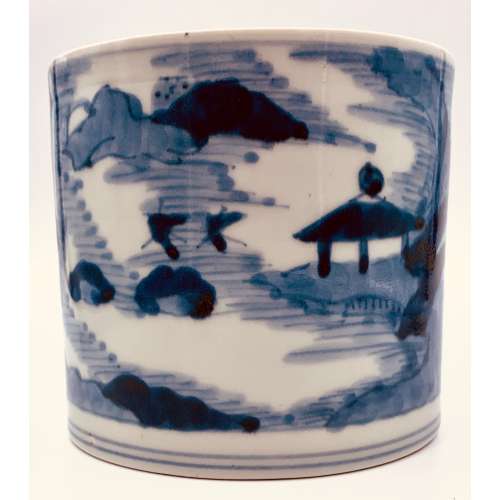
-
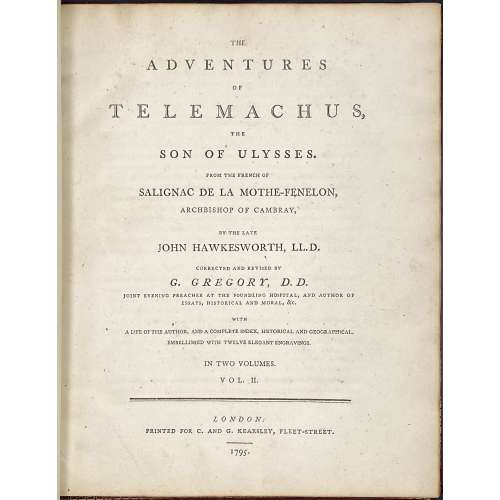 Title page: THE | ADVENTURES | OF | TELEMACHUS, | THE | SON OF ULYSSES. | FROM THE FRENCH OF | SALIGNAC DE LA MOTHE–FENELON, | ARCHBISHOP OF CAMBRAY. | BY THE LATE | JOHN HAWKESWORTH, LL. D. | CORRECTED AND REVISED BY | G. GREGORY, D. D. | JOINT EVENING PREACHER AT THE FOUNDLING HOSPITAL, AND AUTHOR OF | ESSAYS, HISTORICAL AND MORAL, &C. | WITH | A LIFE OF THE AUTHOR, AND A COMPLETE INDEX, HISTORICAL AND GEOGRAPHICAL. | EMBELLISHED WITH TWELVE ELEGANT ENGRAVINGS. | IN TWO VOLUMES. | VOL. I. [VOL. II] | — | LONDON: | PRINTED FOR C. AND G. KEARSLEY, FLEET-STREET. | 1795. || Vol. 1: collation: 2 blank leaves, π6, a-d4, B-Z4 Aa-Ff4, 2 blank leaves, 7 coloured engravings; pagination: [i-v] vi-xxxv [xxxvi], [1] 2-223 [224 blank]. Vol. 2: collation: 2 blank leaves, π4, Gg-Zz4, 3A-3K4 [a]4 b2, 2 blank leaves, 5 coloured engravings; pagination: [i-iii] iv-vii [viii], [225] 226-439, [440-452]. Exterior: 2-volume set, uniformly bound in full crimson linen morocco, key fret inside, gilt-ruled with a floral pattern between fillets to boards, flat spine decorated in gilt, with gilt lettering, marbled endpapers, AEG, 4to, 28 x 22.5 cm; printed on wove paper with watermark “WS”. Blind stamp to ffl by previous owner: "B. J. WIJNVELDT". Engravings: 12 tinted stipple engravings à la poupée: one by James Neagle (British, 1760? – 1822), four by William Bromley (British, 1769 – 1842), four by William Skelton (British, 1763 – 1848), one by John Ogborne (British, 1755 – 1837), and two by James Parker (1750 – 1805) after Thomas Stothard (British, 1755 – 1834). Ref.: Lewine (1898), p. 183: "The 1795 edition, 2 vols., 4to., with 12 engravings after Stothard, has a nominal value." Not in Cohen De Ricci, 1912. Original: François Fénelon. Les Aventures de Télémaque, fils d’Ulysse. See №№ LIB-2522-2020 and LIB-2683.2021 in this collection. John Hawkesworth (British, c. 1715 – 1773). George Gregory (British, 1754 – 1808).
Title page: THE | ADVENTURES | OF | TELEMACHUS, | THE | SON OF ULYSSES. | FROM THE FRENCH OF | SALIGNAC DE LA MOTHE–FENELON, | ARCHBISHOP OF CAMBRAY. | BY THE LATE | JOHN HAWKESWORTH, LL. D. | CORRECTED AND REVISED BY | G. GREGORY, D. D. | JOINT EVENING PREACHER AT THE FOUNDLING HOSPITAL, AND AUTHOR OF | ESSAYS, HISTORICAL AND MORAL, &C. | WITH | A LIFE OF THE AUTHOR, AND A COMPLETE INDEX, HISTORICAL AND GEOGRAPHICAL. | EMBELLISHED WITH TWELVE ELEGANT ENGRAVINGS. | IN TWO VOLUMES. | VOL. I. [VOL. II] | — | LONDON: | PRINTED FOR C. AND G. KEARSLEY, FLEET-STREET. | 1795. || Vol. 1: collation: 2 blank leaves, π6, a-d4, B-Z4 Aa-Ff4, 2 blank leaves, 7 coloured engravings; pagination: [i-v] vi-xxxv [xxxvi], [1] 2-223 [224 blank]. Vol. 2: collation: 2 blank leaves, π4, Gg-Zz4, 3A-3K4 [a]4 b2, 2 blank leaves, 5 coloured engravings; pagination: [i-iii] iv-vii [viii], [225] 226-439, [440-452]. Exterior: 2-volume set, uniformly bound in full crimson linen morocco, key fret inside, gilt-ruled with a floral pattern between fillets to boards, flat spine decorated in gilt, with gilt lettering, marbled endpapers, AEG, 4to, 28 x 22.5 cm; printed on wove paper with watermark “WS”. Blind stamp to ffl by previous owner: "B. J. WIJNVELDT". Engravings: 12 tinted stipple engravings à la poupée: one by James Neagle (British, 1760? – 1822), four by William Bromley (British, 1769 – 1842), four by William Skelton (British, 1763 – 1848), one by John Ogborne (British, 1755 – 1837), and two by James Parker (1750 – 1805) after Thomas Stothard (British, 1755 – 1834). Ref.: Lewine (1898), p. 183: "The 1795 edition, 2 vols., 4to., with 12 engravings after Stothard, has a nominal value." Not in Cohen De Ricci, 1912. Original: François Fénelon. Les Aventures de Télémaque, fils d’Ulysse. See №№ LIB-2522-2020 and LIB-2683.2021 in this collection. John Hawkesworth (British, c. 1715 – 1773). George Gregory (British, 1754 – 1808).George Kearsley the elder (British, 1739 – 1790) (Kearsley, Catharine and George – publishers)


